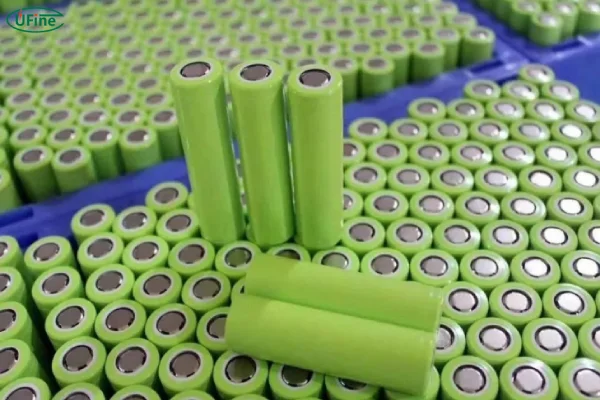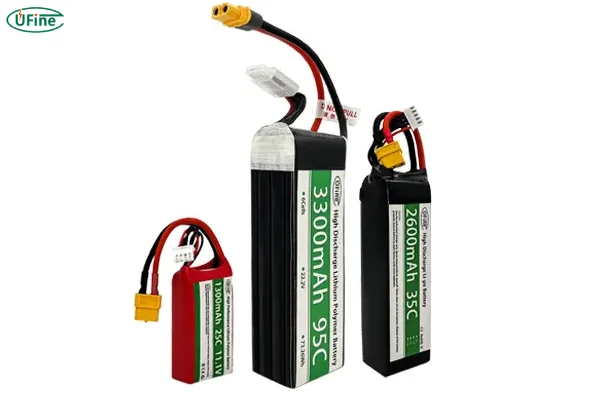
- Part 1. What is a 3C battery? The two key meanings
- Part 2. Types of 3C electronic batteries
- Part 3. Application of 3C electronic batteries
- Part 4. 3C rate battery types: what does the c-rate really mean?
- Part 5. Why is C important for battery performance?
- Part 6. Is the higher the battery c-rate, the better?
- Part 7. Ufine Battery: high rate batteries for every need
- Part 8. Conclusion
If you’re into electronics or anything that runs on batteries, you’ve probably come across the term “3C battery” at some point. But what exactly does it mean, and why should you care?
The term “3C” can refer to two very different things in the world of batteries: the 3C electronic battery and the C-rate (discharge rate) of a battery. Understanding both aspects of 3C batteries is essential for anyone looking to dive deeper into battery performance, efficiency, and applications.Part
In this article, we’ll explore both meanings in detail. We’ll break down what these batteries are, how they work, and where they’re used. Let’s get started!
Part 1. What is a 3C battery? The two key meanings
3C as a Battery Type:
A 3C battery, in one sense, refers to a specific type of battery used in electronic devices. These batteries, often lithium-based, are designed to provide efficient power for small to medium-sized electronics.
3C as a Discharge Rate:
The other meaning of “3C” refers to the C-rate, which indicates how fast a battery discharges its power. A battery’s C-rate is a key factor that determines how quickly the stored energy is released during use. For example, a “3C battery” would discharge its rated capacity three times in one hour.
What does C Mean in Batteries?
Understanding these two aspects of 3C batteries is important because it helps you make informed choices about which battery suits your needs—whether it’s for electronics or high-power applications.
Part 2. Types of 3C electronic batteries
There are various types of 3C batteries based on their chemistry and the specific applications they’re designed for. Here’s a breakdown of the most common types:
Lithium-Ion Batteries (Li-ion):
These are the most widely used in 3C applications, thanks to their high energy density, long lifespan, and relatively lightweight design. They can provide consistent voltage over their discharge cycle and are used in a variety of devices, from smartphones to electric vehicles.
Lithium Polymer Batteries (LiPo):
LiPo batteries are similar to Li-ion but use a gel-like electrolyte. They’re known for their flexibility in design, which makes them ideal for applications that require a custom-shaped battery. LiPo batteries are often used in drones, RC devices, and wearables.
Nickel-Metal Hydride (NiMH):
While less common for high-drain devices than lithium-based batteries, NiMH batteries are still used in some electronic devices. They offer a good balance between capacity and cost but tend to be bulkier than lithium options.
Each of these battery types is designed with specific needs in mind, from portable electronics to more industrial applications. Understanding these distinctions can help you choose the right 3C battery for your needs.
Part 3. Application of 3C electronic batteries
The versatility of 3C batteries makes them suitable for a range of applications across different industries. Here are some of the most common uses:
Consumer Electronics:
3C batteries are found in devices like smartphones, laptops, tablets, and digital cameras. Their ability to deliver reliable power while being compact and lightweight makes them ideal for these devices.
Power Tools:
High-drain power tools like drills, saws, and sanders often use 3C-rated batteries to ensure long-lasting, high-powered performance. The high discharge rate is crucial for these tools, as they require bursts of energy to operate effectively.
Electric Vehicles (EVs):
Lithium-based 3C batteries are used in electric vehicles, including electric bikes and scooters. The ability to discharge at a high rate allows EVs to travel longer distances and charge faster.
Drones and RC Vehicles:
Another area where 3C batteries shine is in drones and remote-controlled vehicles. They offer the high power needed for quick movements and long flights, especially in racing or competitive settings.
Part 4. 3C rate battery types: what does the c-rate really mean?
When it comes to 3C batteries, the “C” rating refers to the rate at which a battery discharges its energy. But what exactly does that mean in practical terms?
Let’s say a battery has a capacity of 1,000 mAh (milliampere-hour). A 1C discharge rate means the battery can provide 1,000 mA for one hour. Similarly, a 3C discharge rate means the battery can discharge 3,000 mA (or 3A) for one hour, releasing its stored energy more quickly.
Why the C-rate matters:
The higher the C-rate, the faster the battery discharges. Higher C-rates are important for applications that require sudden bursts of power, like power tools, drones, and electric vehicles. However, batteries with higher C-rates often have shorter lifespans because they’re stressed more during use.
Types of C-rates:
- 1C: Regular discharge rate, ideal for standard electronics and low-drain devices.
- 3C-5C: Suitable for high-drain devices like drones or power tools.
- 10C and beyond: Used in high-performance applications like racing drones or industrial machinery.
What is a High-Rate Discharge Battery?
Choosing the right C-rate for your application can make all the difference in battery performance, longevity, and overall efficiency.
Part 5. Why is C important for battery performance?
The C-rate is more than just a technical term—it directly affects how a battery performs. A higher C-rate means the battery can deliver more power more quickly. However, it’s a balancing act. If a battery is discharged too quickly (too high of a C-rate), it could overheat, reduce its lifespan, or even cause damage.
Battery Efficiency:
A higher C-rate allows batteries to perform better in demanding applications. But for devices that don’t need a lot of power, a lower C-rate will suffice and provide a longer, more stable battery life.
Thermal Management:
As the C-rate increases, so does the heat generated by the battery. Efficient thermal management is key to ensuring that high-discharge batteries don’t overheat, which is why batteries with higher C-rates often require additional cooling mechanisms.
Part 6. Is the higher the battery c-rate, the better?
You might think that a higher C-rate is always better for performance, but that’s not always the case. Here’s why:
Pros of High C-rate:
- Quick discharge of power, suitable for high-performance devices like drones and power tools.
- Ideal for applications requiring bursts of energy in short periods of time.
Cons of High C-rate:
- Reduced battery lifespan due to the increased stress on the battery.
- More heat is generated, which can cause damage or efficiency loss if not properly managed.
- Higher costs for high C-rate batteries.
The key is to choose a battery with a C-rate that aligns with your needs. If you’re using a device that doesn’t require a huge burst of power, a lower C-rate might actually be a better choice in terms of longevity and cost.
Part 7. Ufine Battery: high rate batteries for every need
If you’re in the market for high-rate batteries, look no further than Ufine Battery. As a leading Chinese lithium battery manufacturer, Ufine specializes in developing and producing high-performance batteries for a variety of applications.
Whether you need lithium-ion, LiFePO4, or any other high-rate battery, Ufine offers customizable options in terms of size, voltage, and capacity. Their batteries are designed to deliver reliable power even in the most demanding conditions.
Part 8. Conclusion
Understanding 3C batteries can be a game-changer when choosing the right power source for your devices. Whether it’s for consumer electronics, power tools, or high-performance vehicles, 3C batteries are the backbone of many modern technologies. By knowing the difference between the types, understanding C-rates, and choosing the right one for your needs, you can ensure better performance, efficiency, and longevity of your devices.
Related Tags:
More Articles

Battery Load Test: A Comprehensive Guide
Step-by-step battery load test guide for car, solar & industrial use. Learn how to load test a battery, interpret voltage charts, and avoid common mistakes.
The Comprehensive Guide to Battery Balancing and Battery Balancer
Discover how battery balancers improve lithium battery performance, lifespan, and safety. Learn types, functions, and tips to choose the right balancer.
What Is the Best Voltage for a Chainsaw Battery?
Compare 12V-80V chainsaw batteries for light pruning, medium firewood, and professional cutting. See best battery chainsaw with runtime charts and safety tips.
Lithium VS. Alkaline Batteries: A Comprehensive Comparison
Lithium batteries last 3–7× longer than alkaline and perform better in cold weather. Compare lifespan, cost, safety, and best uses to choose the right battery.
Comparing Lithium-Sulfur and Lithium-Ion Batteries: Which is Right for You?
Compare lithium-sulfur (Li-S) and lithium-ion batteries on energy, lifespan, cost, safety, and applications. Best choice for drones, EVs, and electronics.





